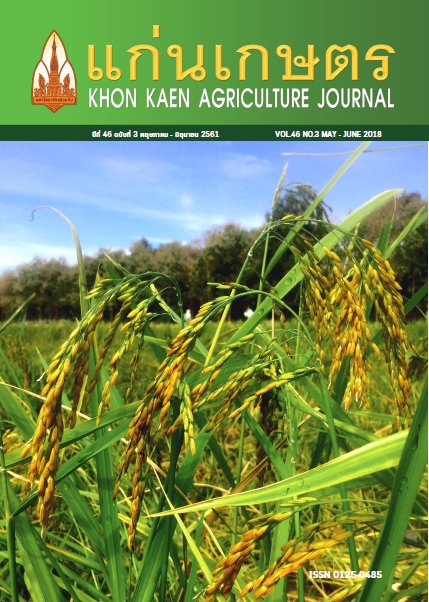การผลิตแบคทีเรียลเซลลูโลสด้วยเชื้อ Acetobacter xylinum โดยการให้น้ำเสียจากกระบวนการแปรรูปสับปะรดเป็นแหล่งคาร์บอน
Main Article Content
บทคัดย่อ
เพื่อลดต้นทุนการผลิตแบคทีเรียลเซลลูโลส (BC) น้ำเสียที่เกิดจากกระบวนการแปรรูปสับปะรดจึงถูกนำมาใช้เป็นแหล่งอาหารเพื่อผลิตแบคทีเรียลเซลลูโลสโดยเชื้อ Acetobacter xylinum พบว่าสามารถผลิตแบคทีเรียลเซลลูโลสได้จากน้ำเสียโดยตรงโดยให้น้ำหนักแห้งของเซลลูโลสเท่ากับ 1.19±0.12 กรัมน้ำหนักแห้งต่อ 100 มิลลิลิตร ของน้ำเสียสับปะรดที่เวลา 10 วัน ซึ่งมีค่าสูงกว่าที่ผลิตได้จากอาหาร HS (0.57±0.31 กรัมน้ำหนักแห้ง) เพื่อเพิ่มผลผลิตของ BC ได้ศึกษาการเติมสารอาหารโพแทสเซียมไดไฮโดรเจนฟอสเฟต (KH2PO4) แมกนีเซียมซัลเฟต (MgSO4) ไดแอมโมเนียมฟอสเฟต ((NH4)2HPO4) แอมโมเนียมซัลเฟต (NH4)2SO4 กรดแอซีติก กรดซิตริก และกรดแอสคอร์บิกที่ความเข้มข้นต่าง ๆ ลงในน้ำเสียจากสับปะรด พบว่าสามารถเพิ่มปริมาณ BC ได้โดยการเติม (NH4)2SO4 ร้อยละ 0.1 ต่อปริมาตร ให้น้ำหนักแห้งของเซลลูโลสถึง 4.05±0.11 กรัม และการเติมกรดแอซีติกความเข้มข้นร้อยละ 1 ให้น้ำหนักแห้งของเซลลูโลสถึง 3.65±0.12 กรัม นอกจากนั้นยังพบว่าการเติมกรดซิตริกยังช่วยเพิ่มคุณสมบัติการอุ้มน้ำของเซลลูโลสที่ผลิตได้จากแบคทีเรียอีกด้วย โดยค่าการอุ้มน้ำเพิ่มขึ้นกว่า 1.22 เท่าจากน้ำเสียจากสับปะรดที่ไม่เติมสารอาหารเพิ่มเติม จากผลการทดลองจะเห็นได้ถึงแนวทางในการลดต้นทุนการผลิตแบคทีเรียลเซลลูโลสโดยใช้น้ำเสียจากกระบวนการผลิตสับปะรดกระป๋ อง อีกทั้งยังสามารถช่วยเพิ่มมูลค่า และลดปริมาณของเสียจากกระบวนการผลิตได้อย่างเหมาะสมอีกด้วย
Article Details
เอกสารอ้างอิง
สุมน โพธิจันทร์. 2552. การใช้ประโยชน์จากวัสดุเหลือใช้ทางการเกษตรเป็นอาหารสัตว์ ศูนย์สารสนเทศและคณะกรรมการจัดการความรู้กรมปศุสัตว์. Available: https://goo.gl/yAfKZw. Accessed: Nov. 24, 2016
Alaban, C. A. 1962. Studies on the optimum conditions for nata de coco bacterium or nata formation in coconut water. Philippine Agriculturist. 45: 490-516.
AOAC. 2000. Official Method of Analysis of AOAC International. 17th ed. The Association of Official Analytical Chemists, Virginia
Carreira, P., J. A. S. Mendes, E. Trovatti, L. S. Serafim, C. S. R. Freire, A. J. D. Silvestre and C. P. Neto. 2011. Utilization of residues from agro-forest industries in the production of high value bacterial cellulose. Bioresource Technology. 102: 7354-7360.
Cheng, K. C., J. M. Catchmark and A. Demirci. 2009. Enhanced production of bacterial cellulose by using a biofilm reactor and its material property analysis. J Biol Eng. 3: 12.
Compendium of Methods for Food Analysis 1sted, Chapter 2, 2003, p. 2-9, Department of Medical Sciences (DMSc), Thailand
Dayal, M. S., N. Goswami, A. Sahai, V. Jain, G. Mathur and A. Mathur. 2013. Effect of media components on cell growth and bacterial cellulose production from Acetobacter aceti MTCC 2623. Carbohydrate Polymers. 94:12-16.
Esa, F., S. M. Tasirin and N. A. Rahman. 2014. Overview of Bacterial Cellulose Production and Application. Agriculture and Agricultural Science Procedia. 2: 113-119.
Goelzer, F. D. E., P. C. S. Faria-Tischer, J. C. Vitorino, M. R. Sierakowski and C. A. Tischer. 2009. Production and characterization of nanospheres of bacterial cellulose from Acetobacter xylinum from processed rice bark. Materials Science and Engineering: C. 29: 546-551.
Gomes, F. P., N. H. C. S. Silva, E. Trovatti, L. S. Serafim, M. F. Duarte, A. J. D. Silvestre, C. P. Neto and C. S. R. Freire. 2013. Production of bacterial cellulose by Gluconacetobacter sacchari using dry olive mill residue. Biomass and Bioenergy. 55: 205-211.
Iguchi, M., S. Yamanaka and A. Budhiono. 2000. Bacterial Cellulose: A Masterpiece of Nature’s Arts. Journal of Materials Science. 35: 261-270.
Keshk, S. M. A. S. 2014. Vitamin C enhances bacterial cellulose production in Gluconacetobacter xylinus. Carbohydrate Polymers. 99: 98-100.
Kongruang, S. 2008. Bacterial Cellulose Production by Acetobacter xylinum Strains from Agricultural Waste Products. Applied Biochemistry and Biotechnology. 148: 245.
Kurosumi, A., C. Sasaki, Y. Yamashita and Y. Nakamura. 2009. Utilization of various fruit juices as carbon source for production of bacterial cellulose by Acetobacter xylinum NBRC 13693. Carbohydrate Polymers. 76:333-335.
Li, Z., L. Wang, J. Hua, S. Jia, J. Zhang and H. Liu. 2015. Production of nano bacterial cellulose from waste water of candied jujube-processing industry using Acetobacter xylinum. Carbohydrate Polymers. 120: 115-119.
Miller, G. L. 1959. Use of Dinitrosalicylic Acid Reagent for Determination of Reducing Sugar. Analytical Chemistry. 31: 426-428.
Pacheco, G., C. R. Nogueira, A. B. Meneguin, E. Trovatti, M. C. C. Silva, R. T. A. Machado, S. J. L. Ribeiro, E. C. da Silva Filho and H. da S. Barud. 2017. Development and characterization of bacterial cellulose produced by cashew tree residues as alternative carbon source. Industrial Crops and Products. 107: 13-19.
Seker, D. C. and N. A. Mohd Zain. 2014. Response surface optimization of glucose production from liquid pineapple waste using immobilized invertase in PVA–alginate–sulfate beads. Separation and Purification Technology. 133: 48-54.
Wu, J.-M. and R.-H. Liu. 2013. Cost-effective production of bacterial cellulose in static cultures using distillery wastewater. Journal of Bioscience and Bioengineering. 115:284-290.
Yang, X.-Y., C. Huang, H.-J. Guo, L. Xiong, J. Luo, B. Wang, X.-F. Chen, X.-Q. Lin & X.-D. Chen. 2014. Beneficial Effect of Acetic Acid on the Xylose Utilization and Bacterial Cellulose Production by Gluconacetobacter xylinus. Indian Journal of Microbiology. 54: 268-273.
Zeng, X., D. P. Small and W. Wan. 2011. Statistical optimization of culture conditions for bacterial cellulose production by Acetobacter xylinum BPR 2001 from maple syrup. Carbohydrate Polymers. 85: 506-513.


